
Say the name Sammy to anyone over a certain age and the first (and perhaps the only) person to come to mind will be the one and only Sammy Davis Jr. It’s therefore entirely fitting that Davis’s musical biography, now playing to audience cheers at San Diego’s Old Globe Theatre, should be titled Sammy. Just Sammy. Simply Sammy. A name that is synonymous with entertainment.
And first-class entertainment Sammy (The Musical) is, its book, music and lyrics written quite fittingly by the man who provided Sammy Davis Jr. with more hit songs than just about anyone else in his career—Leslie Bricusse.
In the title role, Obba Babatundé gives a star-making fireball of a performance. The triple-threat Babatundé may not be a dead ringer for the real Sammy, but by the final curtain, it would be hard to say where our memories of the actual Sammy end and Babatundé-as-Sammy begins. In Sammy, Babatundé has been given the role of a lifetime, and again and again he knocks the ball out of the ballpark, way out.
Sammy’s life and legend, it’s all there, starting from his early years in vaudeville with his dad Sammy Sr. and “uncle” Will Mastin as part of the Will Matsin Trio. (Early for Sammy means starting at the ripe old age of three, which may be one reason why Grandma Rosa wasn’t crazy about the idea of her grandson going on the road.) A later meeting with 10-years-his-senior Frank Sinatra (“Look me up when you get to New York”), a World War II tour of duty in the integrated entertainment Special Services unit (where the previously sheltered Sammy learned about prejudice for the first time), post-war gigs in a segregated Vegas—all of this is a prelude to the stardom that was eventually Sammy’s.
We see Sammy bounce slowly back from the car accident which took his left eye and robbed him temporarily of his center of balance, disastrous for a dancer. We witness his conversion to Judaism. We also observe his relationships with some of the world’s most beautiful women, beginning with movie star Kim Novak, who saw the man and not his color. (“Is he a Negro? I hadn’t noticed.”) Columbia studio head Harry Cohn put an end to that relationship, which was followed by an arranged marriage to the more racially appropriate Loray White. Sammy’s later marriage to blonde Swedish film star May Britt, his relationship with voluptuous Lola Falana, and his third (and twenty-year) marriage to dancer Altovise Gore get the lioness’s share of attention in Act Two.
As conceived by Bricusse, Sammy is a more traditional “book musical” than say Jersey Boys or Ray Charles Live, an approach which works, though you won’t be hearing “Mr. Bojangles” or “I’ve Gotta Be Me” since only songs by Bricusse (or by Bricusse and Anthony Newley) are performed. This omission hardly matters, though, since so many of Sammy’s greatest hits were Bricusse compositions. The Bricusse and Bricusse/Newley hits are performed not simply nightclub style, but also as commentary on Sammy’s life and to move the story forward.
Babatundé’s show-stopping rendition of “Once In A Lifetime” begins Sammy’s show biz journey. “Gonna Build A Mountain” becomes Sammy’s battle cry as he combats prejudice and aims for stardom during his WWII military service. “Who Can I Turn To?” has an eye-patched Sammy wondering if he can ever dance again. “The Joker” is sung as Sammy’s reaction to Harry Cohn’s interference in his love life, and ends Act One with a bang. “The Candy Man” features a 1960s Sammy in Afro and bellbottoms. “What Kind Of Fool Am I?” serves as an older Sammy’s look back and the highs and lows of his life.
Other songs (“Another Hot Day In Harlem,” “Getting My Act Together,” “Livin’ Large”) are new Bricusse creations, proving that the composer has not lost his touch at the age of 78.
Director Keith Glover does exciting work here, and he is blessed with an all-around terrific cast. Ted Louis Levy and Lance Roberts provide sensational support as Sammy Sr. and Will Mastin, and when Batatumbé, Levy, and Roberts are executing choreographer Keith Young’s snappy tap numbers, ovations are in order. Ann Duquesnay is a warm and wonderful Rosa Davis (Sammy’s grandma), singing the sassy “The Buscuit’s Better With The Butter.” Adam Jones, who’s made a successful career with Sinatra tribute shows, proves just why with “Charley Charm” and “Singin’ And Swingin’,” the latter with Troy Britton Johnson, spot-on as Dean Martin. (Johnson also portrays Harry Cohn and Sgt. Jennings.) Mary Ann Hermansen is a gorgeous and gorgeous-voiced Kim Novak, she and Babatundé dueting “Something In Your Smile,” from Dr. Dolittle. Heather Ayers does touching work as May Britt, and joins sexy Keewa Nurullah (Lola Falana) and the beautiful, elegant Victoria Platt (Altovise Gore) in paying musical tribute to Sammy in “The Only Man For Me,” an Act Two highlight. (All three women are fabulous singers.) Completing the outstanding ensemble are Janelle Engleson (WAC), Stephanie Girard, Lauren Haughton (WAC), Perry Ojeda (Eddie Cantor), Anise Ritchie, Alonzo Saunders (Murphy), and dance captain Sarrah Strimel (WAC).
Alexander Dodge has designed some stunning sets, which take us from Harlem to Vegas to Hollywood, and Fabio Toblini’s costumes capture the various eras of Sammy’s life to perfection. Chris Lee’s lighting has just-right Vegas pizzazz. David Partridge’s sound design couldn’t be better, as the music of Sammy fills the Old Globe, the show’s 13-piece orchestra conducted in masterful fashion by Ian Fraser.
Sunday evening’s performance was awarded a standing ovation which began even before the first ensemble members had entered the stage to take their bows. No wonder. Sammy not only pays a well-deserved tribute to one of show biz (and America’s) greats, it entertains from start to finish. When Rosa and Altovise lead the cast in the show’s penultimate number, “The Greatest,” we realize that indeed, for the past two and a half hours, we’ve been in the presence of one of the true giants of 20th Century entertainment.
Old Globe Theatre, Balboa Park, San Diego.
www.oldglobe.org
–Steven Stanley
October 4, 2009
Photos: Craig Schwartz

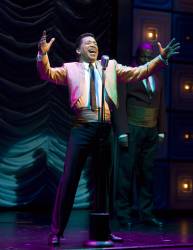
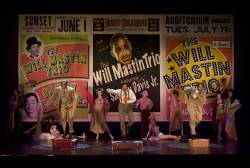
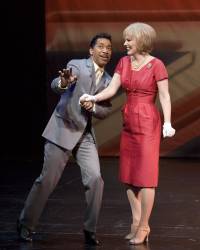
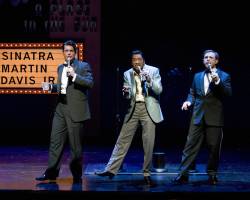
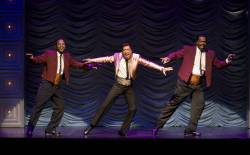
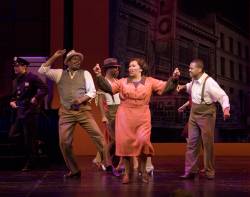

 Since 2007, Steven Stanley's StageSceneLA.com has spotlighted the best in Southern California theater via reviews, interviews, and its annual StageSceneLA Scenies.
Since 2007, Steven Stanley's StageSceneLA.com has spotlighted the best in Southern California theater via reviews, interviews, and its annual StageSceneLA Scenies.







 COPYRIGHT 2024 STEVEN STANLEY :: DESIGN BY
COPYRIGHT 2024 STEVEN STANLEY :: DESIGN BY